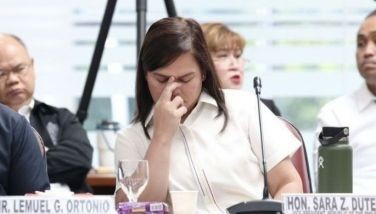Guimaras evacuation order lifted
November 9, 2006 | 12:00am
The National Disaster Coordinating Council (NDCC) recommended yesterday the lifting of the evacuation order it earlier had enforced in the oil spill-affected areas in Guimaras.
With the evacuation order lifted, the residents of 10 coastal villages badly hit by the disaster can now return to their homes.
"We have released a directive or an advisory calling for the lifting of the evacuation order on the affected barangays," said Presidential Adviser for Western Visayas Lito Coscolluela.
In a disaster briefing at Camp Aguinaldo, Coscolluela said an analysis of ambient air samples in the 10 barangays showed that they were free of contamination.
He assured the residents that the level of contamination has gone down and the oil debris collected has been shipped to Mindanao.
"So things are now going to normalize in those affected barangays," he said.
The evacuation order was issued at the height of the environmental disaster caused by the sinking of M/T Solar I off the coast of Guimaras last Aug. 11.
However, Julian Amador, regional executive director of the Department of Environment and Natural Resources (DENR), emphasized though that the Task Force Guimaras’ recommendation only covers the return of the affected coastal folk and does not include the issuance of a "clean bill of health."
"Samples were sent to Manila for testing and the task force cannot issue (a) clean bill of health without those laboratory results," he said.
Coscolluela said the decision of the task force allowing the return of the affected residents was based on thorough deliberation by its member-agencies.
The member-agencies are the University of the Philippines-Visayas, DENR, Department of Health, Department of Agriculture, Coast Guard, Department of Science and Technology, and the local government units of Guimaras.
Meanwhile, the cleanup of mangroves hit by the oil spill has been put on hold for at least three months.
Task Force Guimaras agreed on this to give more time to the concerned agencies to determine the safest method in decontaminating the mangroves.
Earlier, environmentalists raised an alarm over the use of chemical dispersants to clean up the affected mangroves, claiming that they might further damage the mangroves and the surrounding marine areas.
An estimated 16 to 20 percent of the 120 hectares of mangroves in Guimaras have died since the oil spill struck the island-province.
"This is a predicament; there is a debate between the scientific community and the Coast Guard… so we need to test this very well, and learn our lesson from this once and for all," Coscolluela said.
"It is going to be difficult for some people to understand why nothing is going to be done on the dying mangroves… It is going to take a while for everybody to know that it is necessary for scientific trials to be conducted," he added.
Dispersants were also used to clean up mangroves in oil spill-stricken areas on Semirara Island in Antique but scientists have yet to determine any after-effects.
With the evacuation order lifted, the residents of 10 coastal villages badly hit by the disaster can now return to their homes.
"We have released a directive or an advisory calling for the lifting of the evacuation order on the affected barangays," said Presidential Adviser for Western Visayas Lito Coscolluela.
In a disaster briefing at Camp Aguinaldo, Coscolluela said an analysis of ambient air samples in the 10 barangays showed that they were free of contamination.
He assured the residents that the level of contamination has gone down and the oil debris collected has been shipped to Mindanao.
"So things are now going to normalize in those affected barangays," he said.
The evacuation order was issued at the height of the environmental disaster caused by the sinking of M/T Solar I off the coast of Guimaras last Aug. 11.
However, Julian Amador, regional executive director of the Department of Environment and Natural Resources (DENR), emphasized though that the Task Force Guimaras’ recommendation only covers the return of the affected coastal folk and does not include the issuance of a "clean bill of health."
"Samples were sent to Manila for testing and the task force cannot issue (a) clean bill of health without those laboratory results," he said.
Coscolluela said the decision of the task force allowing the return of the affected residents was based on thorough deliberation by its member-agencies.
The member-agencies are the University of the Philippines-Visayas, DENR, Department of Health, Department of Agriculture, Coast Guard, Department of Science and Technology, and the local government units of Guimaras.
Meanwhile, the cleanup of mangroves hit by the oil spill has been put on hold for at least three months.
Task Force Guimaras agreed on this to give more time to the concerned agencies to determine the safest method in decontaminating the mangroves.
Earlier, environmentalists raised an alarm over the use of chemical dispersants to clean up the affected mangroves, claiming that they might further damage the mangroves and the surrounding marine areas.
An estimated 16 to 20 percent of the 120 hectares of mangroves in Guimaras have died since the oil spill struck the island-province.
"This is a predicament; there is a debate between the scientific community and the Coast Guard… so we need to test this very well, and learn our lesson from this once and for all," Coscolluela said.
"It is going to be difficult for some people to understand why nothing is going to be done on the dying mangroves… It is going to take a while for everybody to know that it is necessary for scientific trials to be conducted," he added.
Dispersants were also used to clean up mangroves in oil spill-stricken areas on Semirara Island in Antique but scientists have yet to determine any after-effects.
BrandSpace Articles
<
>
- Latest
- Trending
Trending
Latest
Trending
Latest
Recommended




























